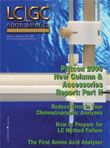New Chromatography Columns and Accessories at the 2006 Pittcon Conference: Part II
LCGC North America
This month's installment of "Column Watch" is the conclusion of a two part series in which Ron Majors examines the trends in columns and sample preparation at Pittcon 2006.
Pittcon 2006 — the 57th Pittsburgh Conference on Analytical Chemistry and Applied Spectroscopy — will return to the Orange County Convention Center in Orlando, Florida on March 12–17, 2006. This year's event will host more than 1000 instrument manufacturers and laboratory suppliers in more than 2300 booths. In addition to attending the exposition, the conferees will have the opportunity to listen to more than 2200 oral and poster presentations, which will include invited and award symposia, check out 50 seminar rooms, or attend one of 100 short courses.
Pittcon remains the most important yearly international analytical exhibition where companies introduce their latest instruments, instrument accessories, columns, sample preparation products, and other consumable products. Because many past attendees have purchased one or more new products within three months after attending the show, most exhibitors attempt to maximize their booth traffic to meet as many potential customers as possible.
The purpose of this report is to provide information about many of the new separation consumables and accessory products that were displayed at Pittcon 2006. In some cases, products that were introduced during 2005 but after Pittcon 2005 (1,2) have been included for reasons of completeness. The information is based upon manufacturers' responses to a questionnaire mailed in December 2005. Because of space limitations and the fact that some manufacturers did not respond to the questionnaire, this report cannot be considered an exhaustive listing of all new products that will be introduced in Orlando. However, over the years, these Pittcon introduction summaries have provided a good source of information that would be difficult for one individual to gather during the four days of the exhibition. In addition, the products introduced have shown definite correlations to current research, development, and application activity in the separation sciences.
As in previous years, columns and other products recommended by their manufacturers primarily for biomolecule separations or sample preparation are denoted in the tables with the designation BIO. Some of these products can be used for general high performance liquid chromatography (HPLC) separations as well, but their main emphasis is for biological samples.
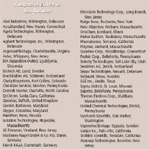
Companies Listed in This Column
In last month's coverage, I described new columns for reversed-phase, normal- and bonded-phase, ion-exchange and ion, size-exclusion, and specialty chromatography (3). In this month's coverage, I look at gas chromatography (GC) columns, supercritical fluid chromatography (SFC) products, sample preparation products, and hardware, and accessories and kits for chromatography and sample preparation.
Gas Chromatography Columns
Although GC is considered to be a relatively mature separation technique, new GC columns continue to be introduced each year at Pittcon (Table I), 20 in all for this year. All columns were the wall-coated open tubular (WCOT) format with the exception of one — the Agilent (Santa Clara, California) GS-OXYPLOT, a specialty PLOT column for oxygenate analysis in the petrochemical industry according to the American Society for Testing Materials (ASTM) methods (4). This column has been optimized for this analysis and can be "dropped-in" with current oxygenate analysis with improved peak shape and better reproducibility compared with current columns.
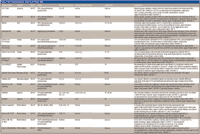
Table I: Gas chromatography columns at Pittcon 2006
In recent years, there has been a trend in the introduction of ultra low-bleed WCOT stationary phases that allowed better detection limits, less baseline drift during temperature programmed separations, and improved compatibility with gas chromatography–mass spectrometry (GC–MS) analyses. This year, almost every GC column had lower than normal bleed specifications. Figure 1 provides experimental data on two of these phases that demonstrates inertness (Figure 1a) or low bleed (Figure 1b). For Figure 1a, the low tailing of pyridine is a good indication of the absence of basic active sites. For Figure 1b, the bleed profiles for a regular 624 column and a new low-bleed column are compared. A column that has lower phase bleed will allow better detection and improved quantitation over a higher bleed column.
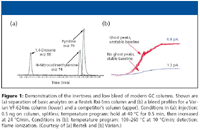
Figure 1
All of the general-purpose GC capillary columns displayed at Pittcon 2006 were crosslinked phases. Crosslinked, chemically bonded, or immobilized phases are more stable, have lower bleed, and usually operate at higher temperatures than coated phases. Another advantage of the bonded phases is their ability to be solvent-rinsed. If a column becomes contaminated by high boilers, inorganic compounds, and other nonvolatile impurities that might cause drifting baselines, bleed, and other undesirable occurrences, it can be disconnected, washed (outlet to inlet direction) with various solvents, and placed back into the gas chromatograph for further use. Capillary columns with internal diameters ranging from 0.10 mm (small bore) to 0.53 mm (large bore or megabore) were the most popular sizes.
High-polarity capillary GC columns always have been tricky to construct because the high-polarity phases are difficult to stick to the fused-silica inner wall. SGE (Austin, Texas) introduced an extremely polar column coated with 90% biscyanopropylpolysiphenylene phase that offers a completely orthogonal approach to the popular nonpolar polysiloxane phases for two-dimensional (2-D) GC. The phase shows strong π–π selectivity for polyunsaturated fatty acid methyl esters and various types of isomers.

Table II: Sample preparation products at Pittcon 2006
Applications-specific columns are always popular introductions at the Exposition. In addition to the oxygenate column, columns for volatile enantiomers, cis–trans fatty acids, pesticides, semivolatile, and volatile organic compounds, and PCBs were among those classes of compounds mentioned. Most of the application-specific columns are pretested and are shipped with test chromatograms.

Table II: Sample preparation products at Pittcon 2006 continued
Sample Preparation Products
As indicated in Table II, Pittcon 2006 was another productive year, with 23 new sample preparation products or families of products displayed. Not counted were sample preparation accessories (Table III) that will be covered later. Among the more popular introductions were products that deal with increasingly smaller amounts of available sample. Cartridges, disks, pipette-tips, well plates, and spin tubes were among the formats introduced.
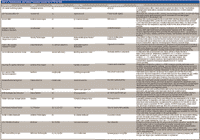
Table III: Chromatography and Sample Preparation Accessories at Pittcon 2006
In the past several years, the 96-well plate design for SPE and filtration has proliferated, driven by the needs of high-throughput sample preparation automation requirements. Compared with last year (2), this year numerous sample preparation plate products were again in evidence. Most of them were solid-phase extraction (SPE) plates or variations of SPE-plates. For example, Glygen (Columbia, Maryland) introduced their lab-on-a-plate well plates where the SPE medium was affixed to the inner surface of the well and rather than a flow-through design, one performs a liquid–solid extraction in a conventional well. Nalge-NUNC's (Rochester, New York) ArrayCote product was of similar design but the wells within a glass plate were functionized with reactive ligands that could be derivatized to form in-situ affinity phases.
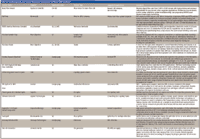
Table III: Chromatography and Sample Preparation Accessories at Pittcon 2006 continued
Argonaut Technologies, now part of Biotage (Charlottesville, Virginia), displayed their flow-through supported liquid extraction plates. Here, the wells are filled with high-purity diatomaceous earth that serves as a support for an extractable aqueous sample, such as blood plasma. Under proper conditions, organic solvent is passed through the wells and a liquid–liquid extraction take place. The organic solvent containing the extracted analytes is collected in a well plate for further treatment.
Other variations of SPE plates were those of Varian (Palo Alto, California), whose 96-well plate had removable flow-through wells that enable users to customize the plate configuration. Such flexibility is useful in method development where several SPE phases can be present in a single plate so that phase scouting can be performed.
Several companies introduced SPE pipette tip–based products that can be used with xyz automated liquid-handling systems. The SPE stationary phase was packed, bonded, or affixed to the tip by various means. For example, in the Thermo Electron (Waltham, Massachusetts) tips, packing was affixed on the inner surface so that flow through the opening was not impeded. In Varian's OMIX, a monolithic packing is used to cut down flow resistance. The opening of the pipette tip is quite small and if the packing is restricted or the small packed bed is plugged with sample particulates, flow can be erratic and nonreproducible results can occur. Other formats for SPE introduced were disk and spin tubes. An example of one of the SPE pipette-tip based products from SeQuant (Umea, Sweden) is depicted in Figure 2. One version, the Zic-tip mini (Figure 2a), has a packed bed containing a zwitterionic hydrophilic interaction chromatography (HILIC) chromatographic resin. The other version, the Zic-tip micro (Figure 2b), has the same packing coated on the inner walls of the pipette tip. Both are used for the extraction of hydrophilic biomolecules, such as glycopeptides, from microliter volumes of biological solutions using typical extraction–elution steps.
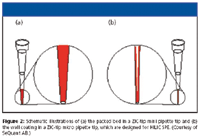
Figure 2
One area of special focus in sample preparation was the high-abundance protein-removal products from Agilent Technologies, BIA Separations (Ljubljana, Slovenia) and Sigma Aldrich (Bellefonte, Pennsylvania). These kits and columns are used in proteomics research where investigators are interested in the presence or absence of low-abundance proteins that can be indicative of disease states. The high-abundance proteins, which constitute 90+% of the proteins in human serum, can mask the lower abundance proteins in 2-D gel or HPLC separations. By removing them, there is a better chance to see the smaller ones. By the use of antibodies to the high-abundance proteins like albumin, IgG and so on, they can be removed or greatly reduced.
Specialized SPE application chemistries also were introduced. Polymeric packings can be used under a wide variety of experimental conditions. Polymeric SPE products were displayed by Hamilton (Reno, Nevada), Polymer Labs (Amherst, Massachusetts), BIA Separations, OroChem Technologies (Lombard, Illinois), and Sepax Technologies (Newark, Delaware). Molecular-imprinted phases are quite popular in Europe, less so in the United States. These phases are very selective due to the presence of molecular imprints of a specific template on the surface of a polymer. Molecular-imprinted phases are prepared by adding a target template molecule to the monomer reaction mixture and forming a polymer around the template. The template is extracted away, leaving behind its imprint on the surface. When a mixture of compounds containing the target molecule is introduced to the molecular-imprinted phase, usually packed into a column or cartridge, there is a stronger affinity for the target molecule by the imprinted site. This is viewed by some as a "lock and key" mechanism. So the process very much resembles affinity attraction. Usually molecular-imprinted phases are customed synthesized but MIP Technologies (Lund, Sweden) has uncovered at least one high-volume application and has developed a molecular-imprinted phase exclusively for chloramphenicol, an antibiotic drug often used in cattle and poultry but banned in many countries. For this molecular-imprinted phase, detection limits well below the minimum performance limit are achieved. Glycopeptide sample preparation by HILIC SPE and a mixed-mode THC phase were some other specialized chemistries shown at Pittcon.
More traditional markets also are addressed. Environmental and food samples often contain low concentrations of contaminants that have to be analyzed and enrichment is often required. SPE is a technique often used for this purpose. New products addressing U.S. EPA methods were introduced by Xenosep Technologies (Boonton, New Jersey) (oil and grease, semivolatiles, chlorinated pesticides, PCBs, and phthalate ester) and Supelco (multiresidue pesticides). The Xenosep Technologies new triple layer SPE filter has been designed for use with EPA Method 1664A. This method is designated for oil and grease analysis and recently the EPA has allowed the use of SPE if equivalency the more accepted hexane extraction method is proven. One of the problems in using SPE devices such as cartridges or disks is that occurrence of plugging due to the presence of particulates, particularly in untreated effluents and in-process wastes. The Xenosep SPE filter (Figure 3) has a coarse layer (traps particles 5–25 μm) followed by an intermediate prefilter layer (traps particles 1–5 μm) followed by the SPE adsorbent layer, which retains the oil and grease compounds. This triple layer concept enables fitration much faster filtration (in a matter of seconds) and provides improved SPE recovery and precision performance.

Figure 3
Chromatography and Sample Preparation Accessories
Table III lists a record-breaking 31 new hardware products and accessories for HPLC, GC, capillary electrophoresis (CE), capillary electrochromatography (CEC), and sample preparation. This year, I have extended the columns and sample preparation accessories to include kits that are designated to solve specific applications problems. All of the products introduced were practical devices designed to make the chromatographer's life easier. I will cover each area individually.
General laboratory products: An automated system for preparation of chemical solutions including HPLC mobile phases including pH adjustment of buffers should make life easier in the laboratory. New vials, caps, and septa including a integrated vial insert system was introduced. Reference standards are always appreciated. A convenient small laboratory cooler that can be used for a variety of cryogenic experiments and sub-ambient storage of samples was displayed.
HPLC, LC–MS, CE–CEC products: Column switching is having a comeback driven by the needs to tackle complex samples such as tryptic protein digests. Systems, trapping columns, and orthogonal column sets were introduced. With the miniaturization in HPLC with shorter and smaller diameter columns as well as high-pressure requirements for longer columns and smaller particles, new lower dead volume and higher pressure rating hardware designs are becoming available so that performance is not compromised. A "see-through" union for low-volume connections for fused silica tubing shows promise. Figure 4 shows the PicoClear Union from New Objective (Woburn, Massachusetts). Unlike fused-silica unions used in nanoLC and CE–CEC that use frusto-conical compression, the absence of mechanical twisting with the PicoClear Union eliminates fused silica grinding and compression and reduces the subsequent likelihood of contamination. Through visual inspection, PicoClear Technology eliminates any question that a connection is leak-free and uncontaminated. Because high-temperature LC is becoming of increasing interest, a standalone mobile phase preheater or post column cooler should aid column performance and detector baseline stability. A new nanoliter flow sensor should help to ensure stable reagent addition or pump flow direct or split-flow output is constant.

Figure 4
GC–SFC products: A large number of convenience products were shown at Pittcon. Gas generators can replace inconvenient and dangerous gas cylinders. New hydrogen and zero air generators were introduced. Gas cylinders in the field are a hassle so that a hydrogen storage system that can operate for long periods of time might be a boon for field GC testing. Improved septa and inert inlet liners are always appreciated. Guard columns, either integrated or external, help to slow down column deterioration. Leak-free unions that do away with press-fit should help those interested in connecting capillary columns, retention or guard columns together. Figure 5 compares a typical GC union stainless steel hardware design with the Ultimate Union Design (Agilent Technologies, Santa Clara, California). In the latter union, the seal is made at the contact of the ferrule (light blue) and the metal fitting (green). The amount of dead (or unswept) volume is limited to a very small space near the tip of the column while the conventional union allows the sample to migrate into long unswept cracks and crevices causing peak tailing. A variable flow splitter for feeding GC column outlet flow to multiple detectors should prove valuable.
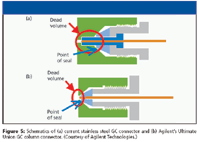
Figure 5
Sample preparation products: The use of vacuum systems for SPE sometimes creates problems with uneven flow and the possibility of drying out cartridges. A positive pressure manifold with individual flow regulators should help out. A low-volume SPE glassware system which is cost effective might prove helpful to sample prep chemists. The automation of solvent evaporation should prove to be a time saving and more reproducible operation and a couple of units for controlled evaporation were introduced.
Acknowledgment
I would like to thank the manufacturers and distributors that kindly furnished the requested information in advance of Pittcon 2006, thus, allowing a timely report on new product introductions. For those manufacturers who would like to be considered for inclusion into Pittcon 2007 coverage, please send the name of the primary company contact, the mailing address, fax number, and e-mail address to Patrick Kempf, Managing Editor, LCGC North America, c/o Advanstar Communications, 485 Rte. 1 South, Bldg. F, Iselin, NJ 08830, Attn.: Pittcon 2007 "Column Watch."
Ronald E. Majors "Column Watch" Editor Ronald E. Majors is business development manager, Consumables and Accessories Business Unit, Agilent Technologies, Wilmington, Delaware, and is a member of LCGC's editorial advisory board. Direct correspondence about this column to "Sample Prep Perspectives," LCGC, Woodbridge Corporate Plaza, 485 Route 1 South, Building F, First Floor, Iselin, NJ 08830, e-mail lcgcedit@lcgc-mag.com.
References
(1) R.E. Majors, LCGC 23(3), 248–265 (2005).
(2) R.E. Majors, LCGC 23(4), 358–369 (2005).
(3) R.E. Majors, LCGC 24(3), pages TK (2006).
(4) I.A.L. Rhodes and A.W. Verstuft, Environmental Testing and Analysis, March/April pp. 24 2001.
New Method Explored for the Detection of CECs in Crops Irrigated with Contaminated Water
April 30th 2025This new study presents a validated QuEChERS–LC-MS/MS method for detecting eight persistent, mobile, and toxic substances in escarole, tomatoes, and tomato leaves irrigated with contaminated water.
University of Tasmania Researchers Explore Haloacetic Acid Determiniation in Water with capLC–MS
April 29th 2025Haloacetic acid detection has become important when analyzing drinking and swimming pool water. University of Tasmania researchers have begun applying capillary liquid chromatography as a means of detecting these substances.
Prioritizing Non-Target Screening in LC–HRMS Environmental Sample Analysis
April 28th 2025When analyzing samples using liquid chromatography–high-resolution mass spectrometry, there are various ways the processes can be improved. Researchers created new methods for prioritizing these strategies.

.png&w=3840&q=75)

.png&w=3840&q=75)



.png&w=3840&q=75)



.png&w=3840&q=75)
